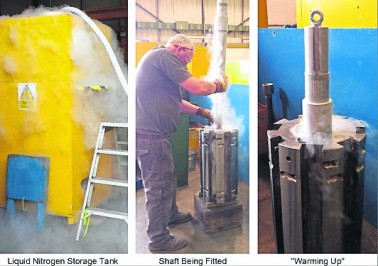THERE are three common ways to join two parts requiring an interference fit: applying force, expanding the outer component by heating it or shrinking the inner component by cooling it.
Historically, the first two methods have been the easiest to achieve, but they both have disadvantages.
THERE are three common ways to join two parts requiring an interference fit: applying force, expanding the outer component by heating it or shrinking the inner component by cooling it.
Historically, the first two methods have been the easiest to achieve, but they both have disadvantages. Force fitting can cause damage to one or both components, applying heat can cause discolouration and distortion and may also cause changes to the structure of the material at a microscopic level which will affect the strength, hardness and brittleness of the component.
An example of a historical application of shrink fitting is the manufacture of cart wheels where a steel or iron rim (tyre) is heated and placed over a wooden wheel. As the rim shrinks it compresses the wooden wheel producing a tightly bound rigid structure.
Train wheels can be constructed in a similar way, a steel tyre is shrink fitted to a steel wheel. This gives the wheel a longer life as the tyre can be replaced as it wears.
More recently it has become possible to use liquified gasses to cool components to extremely low temperatures making the third method of achieving an interference fit a practical proposition. Fitting using cryogenic cooling does not cause discolouration or distortion or structural changes when used with many materials. Changes to the properties of the material are normally temporary and the material will revert to its normal properties once it returns to ambient temperature.
The most common cryogenic fluid used for shrink fitting is liquid nitrogen. Liquid nitrogen boils at 195.8 °C and is extracted by a process of compressing, cooling and then rapidly expanding normal air. The process can be used on many common engineering materials (steel components cooled in liquid nitrogen will shrink by approximately 0.2 per cent) and can be used as a method of joining dissimilar metals. Other applications include: fitting gears to shafts, fitting bearings in housings and fitting valve seats.
The pictures show a steel shaft being shrink fitted into a cast iron cylinder body. Timsons regularly shrink fits components of 100kg and 1,500mm long.
For more information, contact Timsons on 01536 419888 or visit the website www.timsonsengineering.com


